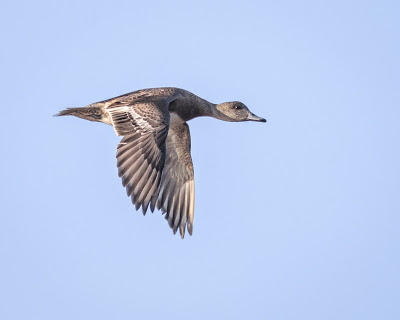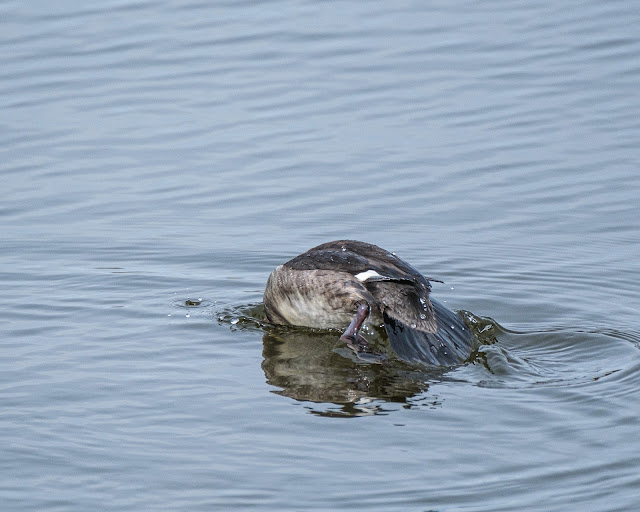First, let's all acknowledge that I'm not much of a bird and wildlife photographer. I don't do it often, but I enjoy it because it is a challenge. Second, I admire those bird and wildlife photographers who create those terrific dramatic and "art" type of photographs. They produce some amazing work. Third, my bird photographs are strictly "record" type shots. There is nothing very good about them nor artistic. Strictly documentary. I wish they were better and maybe one day they will, but for now I'm satisfied with my progress in improving my skills.
I enjoy going out and photographing birds because I enjoy being out in the wild, being immersed in nature, looking at and watching birds of all kinds and because trying to photograph them is a challenge—especially while in-flight. Photographing birds is a pleasure. Okay, now on to how my Fujifilm X-H2S performed with the new 3.0 firmware. In a nutshell, very, very well!
Last week, I met two photography friends at the Outer Banks of North Carolina for a couple of days of bird photography mainly in the numerous wildlife refuges in that area. The two biggest impediments to good photography we found when photographing there were a) we never could position ourselves to get close enough to any of the birds that we could fill the frame with a 35mm equivalent of a 600mm lens, which meant heavy cropping would be necessary and b), in many of the places to which we had access we had to photograph facing south resulting in backlight and a lot of 'sparkles' on the water's surface around the waterfowl. Not good. In other words, the lighting was pretty miserable in many places. Other places it was nice. Most of the images accompanying this post were cropped to about 10% of the original frame, then enlarged a bit in Topaz Gigapixel AI so they were large enough to post adequately. Please take that into account when looking at the photos.
All of the images posted here were made with the Fujifilm X-H2S and the Fujifilm 100-400mm f/4.5-5.6 lens. Almost all were made at the 400mm focal length.
Back in early November I first took my Fujifilm X-H2S out for a few days of bird photography at the Chincoteague National Wildlife Refuge on Virginia's Eastern Shore. I wrote about that trip here. Comparing how the X-H2S performed, in the way of quickly acquiring and holding focus on birds in water, on the ground and in-flight from that last outing to last week's outing with the new software, I found a remarkable difference. The new version 3.0 of the firmware has marginally increased AF speed (the camera was very fast before—no complaints!) but, in my experience under the circumstances under which I photographed, the percentage of in-focus images was greater. Remarkably greater. I haven't calculated the in-focus percentage of images from December nor from last week, but it is easy for me to see in my Lightroom Classic catalog that the number of 'hits' has risen considerably. I was quite surprised.
I would like to say that "if you just point the camera at a bird the AF Subject Detect system will find it and lock onto it immediately." But, not quite. However, I did have several instances when 'all of a sudden' I noticed a duck, goose or white pelican fly by. I swung the camera up, found the bird in the viewfinder, pressed the AF-On button (I'm a diehard back-button focus practitioner) and pressed the shutter. Each time, the camera locked on to the bird almost 100% of my images of the flying bird were in focus. As far as birds on the ground, a perch, in the water and such, the 'hit' rate was also nearly 100%.
The third thing I want to mention is that before, if the bird was backlit or its eye was in shadow, the X-h2S had trouble finding and locking onto it. That was frustrating. That is no longer the case. Whether backlit, sidelit, frontlit, in deep shadow and even in very low light, I found the AF system dramatically improved.
There is one thing that Fujifilm has not addressed that I still consider a shortcoming and that is when there are multiple targets in the viewfinder, the camera decides upon which to lock on and focus. It will also jump from target to target but not nearly as much as before the firmware upgrade. With my Nikon camera, I can use the 4-way button cluster to move the focus box from one subject to another. That simple little ability makes a big difference. I hope Fujifilm will incorporate a similar ability in a future firmware update.
Is the AF system as good as Sony's, Canon's or Nikon's? I have no idea as I don't have any of those very expensive cameras which we know have state-of-the-art AF tracking systems. I will say I am very pleased with the X-H2S now that Fujifilm gave us this significant firmware upgrade. Again, it is not perfect. It is not 100% under all circumstances, but this camera and the 100-400mm f/4.5-5.6 lens I used for the almost 2000 exposures fully meets my needs. In fact, it now exceeds my expectations.
Here are some additional images I made from that short outing.
 |
| A female Hooded Merganser. |
 |
| American Widgeons |
 |
| I wasn't aware White Pelicans frequented NE North Carolina and SE Virginia, but evidently they do. |
 |
| I'm told a swimming Clapper Rail (?) is quite an unusual sight. I was lucky to capture it, especially swimming. |
 |
| Juvenile White Ibis |
A thee image sequence of a female Bufflehead commencing to dive. In the past, I've found
these birds extremely skiddish. I made some of the best images I've ever made of them
on this trip.
 |
| Northern Shoveler. |
A seven image sequence of a male Hooded Merganser. Notice the difference in the shape
of the head in the first and last frames of this sequence.
 |
| Snow Geese circling over a field looking for a place to roost for the night. (click to enlarge) |
 |
| Snow Geese. The sky was completely filled with them. (click to enlarge) |
 |
| Male and female Mallards |
 |
| This female Bufflehead seems to have an itchy ear and is using her left foot to give it a good scratch! lol (click to enlarge) |
The X-H2S now gives me the feeling of confidence and satisfaction that I'm capturing the photographs I want to capture. Before, I felt as though I may be getting them.
If I were a younger man who photographed birds, sports or wildlife full time, I would probably invest the $6000 or more for one of those top-of-the-line cameras and another $15,000 for a 400mm f/2.8 or 600mm f/4 lens as that little bit of edge could be the difference between getting the 'money' shots and missing potentially some of the best ones. But I'm no longer a young man and I photograph now for my own pleasure and the vast majority of my photographic endeavors are not of the bird or wildlife genres. The Fujifilm X-H2S fully serves my needs and I am very happy with the results I've seen so far.
I plan on using and enjoying this camera for a long time to come.
Join me over at my website, https://www.dennismook.com.
Thanks for looking. Enjoy!
Dennis A. Mook
All content on this blog is © 2013-2023 Dennis A. Mook. All Rights Reserved. Feel free to point to this blog from your website with full attribution. Permission may be granted for commercial use. Please contact Mr. Mook to discuss permission to reproduce the blog posts and/or images.
















It is a really great thing to have a reasonable level of confidence that the images are going to be in focus. Very nice photos. The snow geese must have been a spectacular event to experience.
ReplyDeleteThank you. Confidence level and expectations both change. Yes, all of those geese in such a confined area has to be personally seen and heard to appreciate the full effect.
ReplyDelete